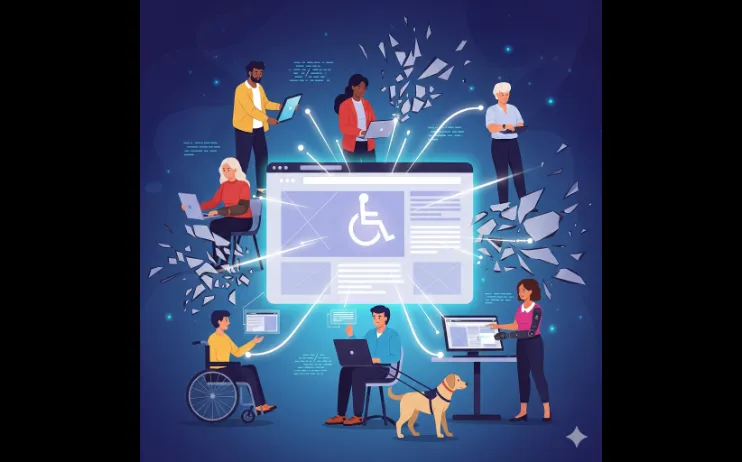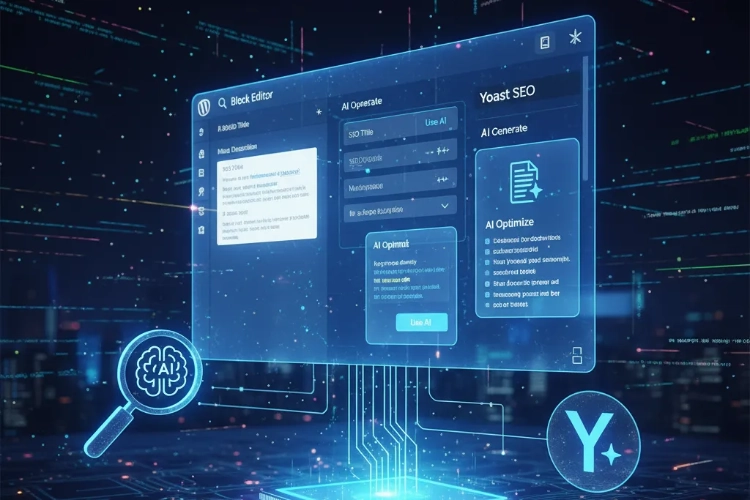Hello, business owners! In today’s digital age, your website isn’t just a marketing tool; it’s often the primary gateway to your products and services. But have you considered if that gateway is open to everyone?
Beyond providing a great user experience and driving sales, your website carries a critical responsibility: accessibility. Many business owners are unaware of the significant and growing legal risks associated with a non-ADA compliant website. Lawsuits regarding website accessibility have been on a sharp upward trend, costing businesses thousands, even millions, in legal fees and settlements.
As a website developer, I’ve seen firsthand how a lack of attention to website accessibility can blindside businesses, regardless of their size. This isn’t just about avoiding a lawsuit; it’s about building an inclusive online presence that serves all your potential customers. This guide will demystify ADA compliance for websites, explain why it’s crucial for your business, and provide you with actionable steps to ensure your digital doors are open to everyone.
What is Website Accessibility? Understanding ADA & WCAG
At its core, website accessibility means designing and developing websites so that people with disabilities can perceive, understand, navigate, and interact with them. This includes individuals with visual, auditory, physical, speech, cognitive, and neurological disabilities.
The primary legal framework driving website accessibility in the United States is the Americans with Disabilities Act (ADA). While the ADA was originally signed into law in 1990, focusing on physical spaces, its principles have been broadly interpreted by courts to apply to digital spaces, including websites. This means your website is considered a “place of public accommodation” and must be accessible.
Globally, the leading guidelines for web accessibility are the Web Content Accessibility Guidelines (WCAG), developed by the World Wide Web Consortium (W3C). WCAG provides a detailed set of recommendations for making web content more accessible. Courts often refer to WCAG 2.0 or 2.1 Level AA as the benchmark for ADA compliance in web cases.
Key takeaway: If your website isn’t accessible, you’re not just alienating a significant portion of the population; you’re also exposing your business to potential legal action.
The Business Case for Accessibility: More Than Just Legal Compliance
While avoiding lawsuits is a powerful motivator, building an accessible website offers substantial benefits that directly impact your business’s success:
1. Expanded Market Reach & Increased Revenue
Approximately 1 in 4 adults in the U.S. have some type of disability, according to the CDC (Centers for Disease Control and Prevention). That’s a massive market segment you might be inadvertently excluding. By making your website accessible, you open your business up to millions of potential customers who can now easily browse your products, read your content, and complete purchases. This directly translates to increased traffic and, crucially, higher revenue for your E-commerce store or service-based business.
2. Enhanced Brand Reputation & Customer Loyalty
In today’s socially conscious marketplace, businesses that demonstrate inclusivity and social responsibility are highly valued. An accessible website signals that your brand cares about all its customers. This fosters goodwill, builds trust, and enhances your brand’s reputation, leading to stronger customer loyalty and positive word-of-mouth.
3. Improved Search Engine Optimization (SEO)
Many accessibility best practices overlap with good Website Optimization for search engines. For example:
- Semantic HTML: Using proper heading structures (
<h1>,<h2>, etc.) and alt text for images not only helps screen readers but also helps search engines understand your content better. - Clear Structure & Navigation: A logical, easy-to-navigate website is beneficial for both users with disabilities and search engine crawlers.
- Transcripts for Media: Providing transcripts for video and audio content makes it accessible to deaf or hard-of-hearing users, and it also gives search engines more text to index.
By making your website accessible, you’re often inherently improving its SEO, leading to higher rankings and more organic traffic.
4. Reduced Legal Risk & Cost
This is often the most immediate concern for business owners. Website accessibility lawsuits are not just limited to large corporations; small and medium-sized businesses are increasingly becoming targets. Settlements, legal fees, and the cost of remediation can be devastating. Proactive ADA compliance is a far more cost-effective strategy than reactive litigation. Staying compliant protects your business from expensive legal battles and reputational damage.
The Accessibility Checklist: Common Issues to Address
So, what are the common areas where websites often fall short in terms of accessibility? Here’s an actionable checklist to help you identify potential issues on your own business website:
1. Images & Non-Text Content
- Alt Text: Does every meaningful image on your site have descriptive “alt text”? This text is read by screen readers to describe the image to visually impaired users. It’s also crucial for SEO! (WCAG 1.1.1)
- Complex Visuals: For complex graphs, charts, or infographics, is there a longer text description or data table provided elsewhere on the page?
2. Keyboard Navigation
- Tab Order: Can users navigate every interactive element (links, buttons, form fields) on your site using only the keyboard’s Tab key? The focus order should be logical. (WCAG 2.1.1)
- Focus Indicator: Is there a clear visual indicator (like a highlight or border) showing which element is currently in focus when using keyboard navigation? (WCAG 2.4.7)
3. Color & Contrast
- Sufficient Contrast: Is there enough color contrast between text and its background? Users with low vision or color blindness may struggle to read text with low contrast. Tools like WebAIM’s Contrast Checker can help you test this. (WCAG 1.4.3)
- Color Not the Only Indicator: Is color the only way you convey important information? For example, don’t use red text alone to indicate an error; also include an icon or bold text. (WCAG 1.4.1)
4. Forms & Interactive Elements
- Labels for Form Fields: Does every form field have a clear, associated text label? This helps screen readers understand what information is required. (WCAG 1.3.1, 3.3.2)
- Error Identification: When a form error occurs, is the error clearly explained in text and easy to find? (WCAG 3.3.1)
- Accessible Buttons & Links: Are buttons and links clearly identifiable and descriptive? Avoid generic “Click Here” links. (WCAG 2.4.4)
5. Headings & Structure
- Logical Heading Structure: Do you use HTML headings (
<h1>,<h2>, etc.) in a logical, hierarchical order? This helps screen reader users navigate content quickly. (WCAG 1.3.1, 2.4.6) - Semantic HTML: Are you using appropriate HTML tags (e.g.,
<nav>for navigation,<footer>for footers) to define the structure and meaning of your content?
6. Video & Audio Content
- Captions/Transcripts: Do all videos have accurate closed captions or a text transcript? (WCAG 1.2.1, 1.2.2)
- Audio Descriptions: For videos where visual information is critical and not conveyed through audio, is an audio description provided? (WCAG 1.2.5)
7. Language & Readability
- Page Language: Is the default language of the page specified in the HTML? (WCAG 3.1.1)
- Clear Language: Is the content written in clear, simple language as much as possible?
This is not an exhaustive list, but it covers many of the common pitfalls. Regularly reviewing these items can help you maintain a more accessible site. For a comprehensive audit and detailed guidelines, refer to the full WCAG 2.1 documentation.
Why You Need a Professional: Beyond the Checklist
While the checklist above provides a great starting point, achieving true ADA compliance and a seamlessly accessible website is complex. It involves more than just ticking boxes; it requires a deep understanding of design, development, and the varied ways people interact with technology.
- Technical Implementation: Many accessibility features require specific coding practices that go beyond what a visual page builder can provide. Correct semantic HTML, ARIA attributes, and JavaScript accessibility enhancements are best handled by experienced developers. Our WordPress Development team is well-versed in these technical nuances.
- Comprehensive Auditing: Manual checks are helpful, but professional accessibility audits use specialized tools and techniques (including testing with screen readers and other assistive technologies) to uncover hidden issues that might not be obvious.
- Ongoing Maintenance: Websites are dynamic. As you add new content, plugins, or features, new accessibility barriers can inadvertently be introduced. A professional partner can help you maintain compliance over time.
- Legal Expertise (indirectly): While a developer isn’t a lawyer, working with one ensures your site is built to meet the recognized WCAG standards that are often cited in legal cases.
- Custom Solutions: Your business might have unique content or interactive elements that require custom accessibility solutions. Our Custom Projects service is designed to tackle these specific challenges.
Attempting a DIY approach to website accessibility can easily lead to partial solutions that might still expose you to legal risk. Partnering with experienced professionals ensures that your website is not just compliant, but genuinely usable and welcoming for all visitors. Our Website Design philosophy at Rudtek prioritizes inclusive design from the ground up, ensuring your site is beautiful, functional, and accessible.
What’s Next?
Understanding website accessibility and ADA compliance is a critical step towards building a successful and responsible online business. It’s an investment that pays off in expanded reach, enhanced reputation, improved SEO, and invaluable peace of mind.
- What’s one accessibility issue you’ve identified on your own website after reading this?
- Have you ever encountered an inaccessible website as a user, and how did it impact your experience?
- What steps are you planning to take to ensure your website is fully accessible?
Share your thoughts and questions in the comments below! If you’re ready to ensure your website is fully accessible and legally compliant, the expert team at Rudtek is here to guide you. Contact us today for a professional assessment of your website’s accessibility and learn how we can help you build an inclusive and future-proof online presence.







